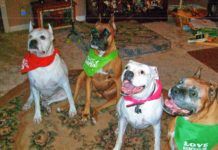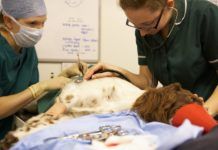Dear Doctor: One Bordetella Shot Too Many?
We have four senior Boxers: one 9-year-old male, one 10-year-old female, and two littermates age 12. They are up to date on their Bordetella shots and all other required vaccinations as of eight months ago. However, the boarding facility we use regularly recently started a new policy that boarders must have had their Bordetella shots within the last six months to be allowed to stay there.
Can Flea Collars Cause Seizures in Dogs?
I have an older dog - a 10-year-old golden retriever - that I just adopted from a rescue. When I put a Seresto flea and tick collar on her, she started having seizures. She no longer has the collar but is now on phenobarbital to control the seizures. What do you advise using for flea and tick control on a dog that has a history of seizures? I know that the new pill is not advised for these dogs.
Teeth Cleanings Without Anesthesia on Dogs?
We frequently remind our readers that dogs need to be anesthetized when having their teeth cleaned because our pets do not sit still and open wide. In fact, we said it as recently as our July issue.
That prompted Your Dog reader Pamela Skinner of Goshen, Massachusetts, to write in. A couple of her own dogs had already undergone anesthesia-free dental cleanings, with results she was very happy with.
Our veterinary practice has begun using an outside service for routine cleanings, she said.
Cherry Eye in Dogs
Julie Hellner of Ash Flat, Arizona, is more than a little concerned. Her seven-year-old Jack Russell-shih tzu mix, Maxwell, has had a condition called cherry eye on and off for the past four to five years. The name comes from the fact that cherry eye is characterized by a rather large reddish mass appearing on the eyeball.
Obesity Drugs and Surgery for Overweight Dogs?
There are some situations that Ive personally encountered where standard weight loss - diet and exercise - just isnt possible, says Deborah Linder, DVM, DACVM, who heads the Tufts Obesity Clinic for Animals. One example was a household that had a family member with Alzheimers disease. That person could never remember if she fed the dog and kept giving him meals, so in that case we considered medication.
Dog Care & Nutrition: How to Fight Fleas on your Dog
Fleas are prolific, producing thousands of eggs during their three- to four-month lifespan. In ideal conditions, the cycle takes just two weeks from egg-laying (the female can lay as many as fifty eggs in a single day and starts laying eggs within a day of landing on your dog) to larvae to pupae to hatched fleas capable of laying eggs of their own. And, fleas can live from twelve days to six months.Depending on where you live, flea season can be a year-round problem or limited to four or so months annually. They thrive in warm, humid weather. The U.S. Food and Drug Administration estimates there are more than two hundred species of fleas in this country. The American Veterinary Medicine Association estimates that flea-related disease account for 35 percent of visits to all small animal veterinary practices and 50 percent of all skin problems veterinarians see.
How to Tell If Your Dog is Having a Stroke
Its one of those conditions that, with the advent and then greater usage of MRI, were starting to figure out that dogs truly do have strokes, probably with a greater frequency than we once thought, says veterinary neurologist Casey Neary, DVM, DACVIM, who works out of the Atlanta offices of Bush Veterinary Neurology Service, the largest veterinary neurological practice in the world. To be sure, Dr. Neary says, the overall occurrence of stroke is rare, not as common as in humans.
If The Dog Is Fat, Is the Cancer Prognosis Worse?
It has already been well established that people who are obese are more likely to develop cancer than people of healthy weight. There are a lot of different theories on why, says Tufts veterinary nutritionist Cailin Heinze, VMD, DACVM. One of the main ones, she comments, is that obesity is a chronic inflammatory condition. Its thought that some inflammatory chemical triggers that shouldnt normally be floating around in your bloodstream in relatively high amounts could set things in motion by causing changes in cells that lead to the growth of malignant tumors.
Dear Doctor – Getting over the hump
Q I have a dog rescued from a neglectful situation - a Papillion about nine years old, the vet thinks. We have been together for three months, and he is coming along nicely. But he likes to hump when he plays with our neighbors dog.
Dear Doctor – Chronic urinary tract infections
Q My eight-year-old schnauzer-elk hound mix is a wonderful companion. However, I am concerned as she has chronic urinary tract infections that are expensive to treat; the vet gives her injections and antibiotics.
Dear Doctor – Reducing heartworm risk
Q Ive seen advice for reducing mosquitoes on your property to help dogs avoid the heartworm disease that the insects transmit, but is that really necessary if you already give your dog preventative heartworm medicine?
Dear Doctor – Testing positive for Lyme disease even with no symptoms
Q I have a healthy 5-year-old female golden retriever who was treated for Lyme disease last year but tested positive again this year...











